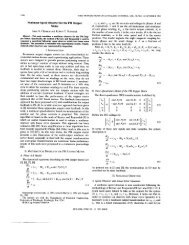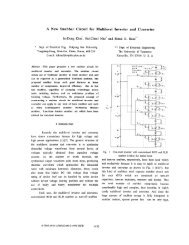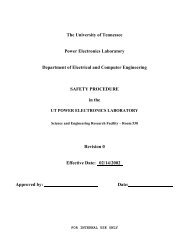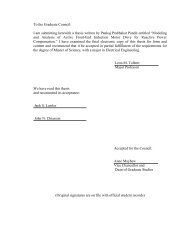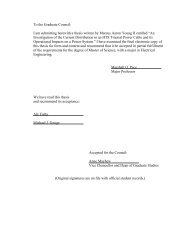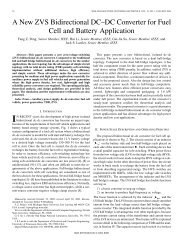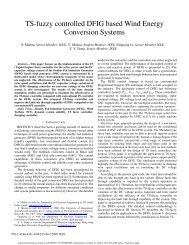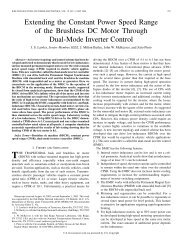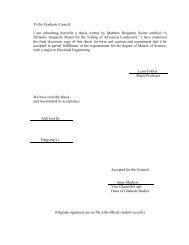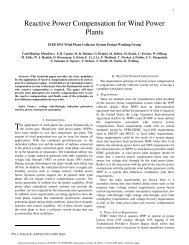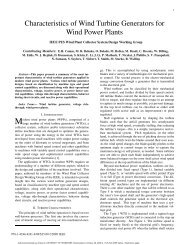Maximum Constant Boost Control of the Z-Source Inverter
Maximum Constant Boost Control of the Z-Source Inverter
Maximum Constant Boost Control of the Z-Source Inverter
You also want an ePaper? Increase the reach of your titles
YUMPU automatically turns print PDFs into web optimized ePapers that Google loves.
<strong>Maximum</strong> <strong>Constant</strong> <strong>Boost</strong> <strong>Control</strong> <strong>of</strong> <strong>the</strong><br />
Z-<strong>Source</strong> <strong>Inverter</strong><br />
Miaosen Shen 1 , Jin Wang 1 ,Alan Joseph 1 , Fang Z. Peng 1 , Leon M. Tolbert 2 , and Donald J. Adams 3<br />
1 Michigan State University<br />
Department <strong>of</strong> Electrical and Computer Engineering<br />
2120 Engineering Building, East Lansing, MI 48824<br />
Phone: 517-432-3331, Fax: 517-353-1980, Email: fzpeng@egr.msu.edu<br />
2 University <strong>of</strong> Tennessee, 3 Oak Ridge National Laboratory<br />
Abstract: This paper proposes two maximum constant boost<br />
control methods for <strong>the</strong> Z-source inverter, which can obtain<br />
maximum voltage gain at any given modulation index without<br />
producing any low-frequency ripple that is related to <strong>the</strong> output<br />
frequency. Thus <strong>the</strong> Z-network requirement will be independent<br />
<strong>of</strong> <strong>the</strong> output frequency and determined only by <strong>the</strong> switching<br />
frequency. The relationship <strong>of</strong> voltage gain to modulation index is<br />
analyzed in detail and verified by simulation and experiment.<br />
Keywords- Z-source inverter; PWM; Voltage boost;<br />
INTRODUCTION<br />
In a traditional voltage source inverter, <strong>the</strong> two switches<br />
<strong>of</strong> <strong>the</strong> same phase leg can never be gated on at <strong>the</strong> same time<br />
because doing so would cause a short circuit (shoot-through)<br />
to occur that would destroy <strong>the</strong> inverter. In addition, <strong>the</strong><br />
maximum output voltage obtainable can never exceed <strong>the</strong> dc<br />
bus voltage. These limitations can be overcome by <strong>the</strong> new<br />
Z-source inverter [1], shown in Fig. 1, that uses an impedance<br />
network (Z-network) to replace <strong>the</strong> traditional dc link. The<br />
Z-source inverter advantageously utilizes <strong>the</strong> shoot-through<br />
states to boost <strong>the</strong> dc bus voltage by gating on both <strong>the</strong> upper<br />
and lower switches <strong>of</strong> a phase leg. Therefore, <strong>the</strong> Z-source<br />
inverter can buck and boost voltage to a desired output voltage<br />
that is greater than <strong>the</strong> available dc bus voltage. In addition,<br />
<strong>the</strong> reliability <strong>of</strong> <strong>the</strong> inverter is greatly improved because <strong>the</strong><br />
shoot-through can no longer destroy <strong>the</strong> circuit. Thus it<br />
provides a low-cost, reliable, and highly efficient single-stage<br />
structure for buck and boost power conversion.<br />
The main circuit <strong>of</strong> <strong>the</strong> Z-source inverter and its<br />
operating principle have been described in [1]. <strong>Maximum</strong><br />
boost control is presented in [2]. In this paper, we will present<br />
two control methods to achieve maximum voltage boost/gain<br />
while maintaining a constant boost viewed from <strong>the</strong> Z-source<br />
network and producing no low-frequency ripple associated<br />
with <strong>the</strong> output frequency. This maximum constant boost<br />
control can greatly reduce <strong>the</strong> L and C requirements <strong>of</strong> <strong>the</strong><br />
Z-network. The relationship <strong>of</strong> voltage boost and modulation<br />
index, as well as <strong>the</strong> voltage stress on <strong>the</strong> devices, will be<br />
investigated.<br />
. VOLTAGE BOOST,STRESS AND CURRENT RIPPLE<br />
As described in [1], <strong>the</strong> voltage gain <strong>of</strong> <strong>the</strong> Z-source<br />
inverter can be expressed as<br />
Vˆ<br />
o<br />
= MB , (1)<br />
V / 2<br />
dc<br />
where o Vˆ is <strong>the</strong> output peak phase voltage, Vdc is <strong>the</strong> input dc<br />
voltage, M is <strong>the</strong> modulation index, and B is <strong>the</strong> boost factor.<br />
B is determined by<br />
1<br />
B = , (2)<br />
T0<br />
1−<br />
2<br />
T<br />
where T0 is <strong>the</strong> shoot-through time interval over a switching<br />
T 0 cycle T, or = D0<br />
is <strong>the</strong> shoot-through duty ratio.<br />
T<br />
In [1], a simple boost control method was used to control<br />
<strong>the</strong> shoot-through duty ratio. The Z-source inverter<br />
maintains <strong>the</strong> six active states unchanged as in traditional<br />
carrier-based pulse width modulation (PWM) control. In this<br />
case, <strong>the</strong> shoot-through time per switching cycle is constant,<br />
which means <strong>the</strong> boost factor is a constant. Therefore, under<br />
this condition, <strong>the</strong> dc inductor current and capacitor voltage<br />
have no ripples that are associated with <strong>the</strong> output frequency.<br />
As has been examined in [2], for this simple boost control, <strong>the</strong><br />
obtainable shoot-through duty ratio decreases with <strong>the</strong><br />
increase <strong>of</strong> M, and <strong>the</strong> resulting voltage stress across <strong>the</strong><br />
devices is fairly high. To obtain <strong>the</strong> maximum voltage boost,<br />
[2] presents <strong>the</strong> maximum boost control method as shown in<br />
Fig. 2, which shoots through all zero-voltage vectors entirely.<br />
Based on <strong>the</strong> map in Fig. 2, <strong>the</strong> shoot-through duty cycle D0<br />
varies at six times <strong>the</strong> output frequency. As can be seen from<br />
[2], <strong>the</strong> voltage boost is inversely related to <strong>the</strong> shoot-though<br />
duty ratio; <strong>the</strong>refore, <strong>the</strong> ripple in shoot-through duty ratio will<br />
result in ripple in <strong>the</strong> current through <strong>the</strong> inductor, as well as<br />
in <strong>the</strong> voltage across <strong>the</strong> capacitor. When <strong>the</strong> output frequency<br />
is low, <strong>the</strong> inductor current ripple becomes significant, and a<br />
large inductor is required.<br />
IAS 2004 142<br />
0-7803-8486-5/04/$20.00 © 2004 IEEE
+<br />
_ V dc<br />
S ap<br />
S bp<br />
S cp<br />
S an<br />
S bn<br />
S cn<br />
D 0<br />
<br />
C 1<br />
<br />
π<br />
6<br />
L 1<br />
L 2<br />
C 2<br />
V i<br />
a p b p c p<br />
Fig. 1 Z-source inverter<br />
<br />
π<br />
2<br />
a n b n c n To ac Load<br />
or Motor<br />
5<br />
6<br />
Fig. 2 <strong>Maximum</strong> boost control sketch map<br />
To calculate <strong>the</strong> current ripple through <strong>the</strong> inductor, <strong>the</strong><br />
circuit can be modeled as in Fig. 3, where L is <strong>the</strong> inductor in<br />
<strong>the</strong> Z-source network, Vc is <strong>the</strong> voltage across <strong>the</strong> capacitor in<br />
<strong>the</strong> Z-source network, and Vi is <strong>the</strong> voltage fed to <strong>the</strong> inverter.<br />
Neglecting <strong>the</strong> switching frequency element, <strong>the</strong> average value<br />
<strong>of</strong> Vi can be described as<br />
From [2], we have<br />
D<br />
0<br />
i<br />
dc<br />
<br />
V = 1−<br />
D ) * BV . (3)<br />
( θ )<br />
= 1−<br />
( 0<br />
2<br />
2 − ( M sinθ<br />
− M sin( θ − π ))<br />
=<br />
3<br />
2<br />
3 1<br />
M cos( θ − π )<br />
2 3<br />
π<br />
( < θ <<br />
6<br />
π<br />
)<br />
2<br />
and B =<br />
3<br />
π<br />
.<br />
3M<br />
−π<br />
(5)<br />
As can be seen from Eq. (4), D 0 has maximum value when<br />
π<br />
π<br />
θ = and has minimum value when θ = or<br />
3<br />
6<br />
π<br />
θ = . If<br />
2<br />
(4)<br />
we suppose <strong>the</strong> voltage across <strong>the</strong> capacitor is constant, <strong>the</strong><br />
voltage ripple across <strong>the</strong> inductor can be approximated as a<br />
sinusoid with peak-to-peak value <strong>of</strong><br />
V<br />
pk 2 pk<br />
= (<br />
= V<br />
3<br />
M −<br />
2<br />
i max<br />
−V<br />
3 3<br />
( − ) Mπ<br />
= 2 4 V<br />
3 3M<br />
−π<br />
i min<br />
3 π<br />
M cos( )) * BV<br />
2 6<br />
dc<br />
dc<br />
. (6)<br />
If <strong>the</strong> output frequency is f, <strong>the</strong> current ripple through <strong>the</strong><br />
inductor will be<br />
∆I<br />
L<br />
Vpk<br />
2 pk<br />
=<br />
2*<br />
π * 6 f * L<br />
3 3<br />
( − ) MVdc<br />
= 2 4<br />
12 * ( 3 3M<br />
−π<br />
) fL<br />
. (7)<br />
As can be seen from Eq. (7), when <strong>the</strong> output frequency<br />
decreases, in order to maintain <strong>the</strong> current ripple in a certain<br />
range, <strong>the</strong> inductor has to be large.<br />
<br />
<br />
Fig. 3 Model <strong>of</strong> <strong>the</strong> circuit<br />
.MAXIMUM CONSTANT BOOST CONTROL<br />
In order to reduce <strong>the</strong> volume and cost, it is important<br />
always to keep <strong>the</strong> shoot-through duty ratio constant. At <strong>the</strong><br />
same time, a greater voltage boost for any given modulation<br />
index is desired to reduce <strong>the</strong> voltage stress across <strong>the</strong><br />
switches. Figure 4 shows <strong>the</strong> sketch map <strong>of</strong> <strong>the</strong> maximum<br />
constant boost control method, which achieves <strong>the</strong> maximum<br />
voltage gain while always keeping <strong>the</strong> shoot-through duty<br />
ratio constant. There are five modulation curves in this control<br />
method: three reference signals, Va, Vb, and Vc, and two<br />
shoot-through envelope signals, Vp and Vn. When <strong>the</strong> carrier<br />
triangle wave is greater than <strong>the</strong> upper shoot-through envelope,<br />
Vp, or lower than <strong>the</strong> lower shoot-through envelope, Vn, <strong>the</strong><br />
inverter is turned to a shoot-through zero state. In between, <strong>the</strong><br />
inverter switches in <strong>the</strong> same way as in traditional<br />
carrier-based PWM control.<br />
Because <strong>the</strong> boost factor is determined by <strong>the</strong><br />
shoot-though duty cycle, as expressed in [2], <strong>the</strong><br />
shoot-through duty cycle must be kept <strong>the</strong> same in order to<br />
maintain a constant boost. The basic point is to get <strong>the</strong><br />
maximum B while keeping it constant all <strong>the</strong> time. The upper<br />
and lower envelope curves are periodical and are three times<br />
IAS 2004 143<br />
0-7803-8486-5/04/$20.00 © 2004 IEEE
<strong>the</strong> output frequency. There are two half-periods for both<br />
curves in a cycle.<br />
Voltage gain (MB)<br />
16<br />
14<br />
12<br />
10<br />
<br />
<br />
<br />
π<br />
3<br />
<br />
<br />
2π<br />
3<br />
Fig. 4 Sketch map <strong>of</strong> constant boost control<br />
8<br />
6<br />
4<br />
2<br />
0<br />
0.5 0.6 0.7 0.8 0.9 1<br />
Modulation index (M)<br />
Fig. 5 Vac/0.5V0 versus M<br />
For <strong>the</strong> first half-period, (0, /3) in Fig. 4, <strong>the</strong> upper<br />
and lower envelope curves can be expressed by Eqs. (8) and<br />
(9), respectively.<br />
2π<br />
π<br />
Vp 1 = 3M<br />
+ sin( θ − ) M 0 < θ < . (8)<br />
3<br />
3<br />
2π<br />
π<br />
Vn 1 = sin( θ − ) M<br />
0 < θ < . (9)<br />
3<br />
3<br />
For <strong>the</strong> second half-period (/3, 2/3), <strong>the</strong> curves meet<br />
Eqs. (10) and (11), respectively.<br />
π 2π<br />
Vp 2 = sin( θ ) M<br />
< θ < . (10)<br />
3 3<br />
Vn 2 = sin( θ ) M − 3M<br />
π 2π<br />
< θ < . (11)<br />
3 3<br />
Obviously, <strong>the</strong> distance between <strong>the</strong>se two curves is<br />
always constant, that is, 3 M . Therefore <strong>the</strong> shoot-through<br />
duty ratio is constant and can be expressed as<br />
T0<br />
2 − 3M<br />
3M<br />
= = 1−<br />
. (12)<br />
T 2 2<br />
The boost factor B and <strong>the</strong> voltage gain can be calculated:<br />
1<br />
B =<br />
T0<br />
1−<br />
2<br />
T<br />
=<br />
1<br />
.<br />
3M<br />
−1<br />
(13)<br />
vˆ<br />
o = MB =<br />
Vdc<br />
/ 2<br />
M<br />
.<br />
3M<br />
−1<br />
(14)<br />
The curve <strong>of</strong> voltage gain versus modulation index is<br />
shown in Fig. 5. As can be seen in Fig. 5, <strong>the</strong> voltage gain<br />
approaches infinity when M decreases to<br />
3<br />
.<br />
3<br />
This maximum constant boost control can be<br />
implemented using third harmonic injection [3]. A sketch map<br />
<strong>of</strong> <strong>the</strong> third harmonic injection control method, with 1/6 <strong>of</strong> <strong>the</strong><br />
third harmonic, is shown in Fig. 6. As can be seen from Fig. 6,<br />
Va reaches its peak value<br />
3<br />
M while Vb is at its minimum<br />
2<br />
value -<br />
3<br />
M . Therefore, a unique feature can be obtained:<br />
2<br />
only two straight lines, Vp and Vn, are needed to control <strong>the</strong><br />
shoot-through time with 1/6 (16%) <strong>of</strong> <strong>the</strong> third harmonic<br />
injected.<br />
<br />
<br />
<br />
<br />
<br />
<br />
<br />
<br />
<br />
<br />
<br />
π<br />
3<br />
Fig. 6 Sketch map <strong>of</strong> constant boost control with third harmonic<br />
injection<br />
The shoot-through duty ratio can be calculated by<br />
T0<br />
2 − 3M<br />
3M<br />
= = 1−<br />
. (15)<br />
T 2 2<br />
As we can see, it is identical to <strong>the</strong> previous maximum<br />
constant boost control method. Therefore, <strong>the</strong> voltage gain can<br />
also be calculated by <strong>the</strong> same equation. The difference is that<br />
2<br />
in this control method, <strong>the</strong> range <strong>of</strong> M is increased to 3 .<br />
3<br />
The voltage gain versus M is shown in Fig.7. The voltage gain<br />
can be varied from infinity to zero smoothly by increasing M<br />
IAS 2004 144<br />
0-7803-8486-5/04/$20.00 © 2004 IEEE<br />
<br />
2π<br />
3
3 2<br />
from to with shoot-through states (solid curve in<br />
3 3<br />
Fig. 7) and <strong>the</strong>n decreasing M to zero without shoot-through<br />
states (dotted curve in Fig. 7).<br />
Voltage gain (MB)<br />
16<br />
14<br />
12<br />
10<br />
8<br />
6<br />
4<br />
2<br />
0<br />
0 0.2 0.4 0.6 0.8 1 1.2<br />
Modulation index (M)<br />
Fig. 7 Vac/0.5V0 versus M<br />
.VOLTAGE STRESS COMPARISON<br />
As defined in [2], voltage gain G is<br />
G = MB =<br />
We have<br />
M<br />
.<br />
3M −1<br />
(16)<br />
M =<br />
G<br />
.<br />
3G −1<br />
(17)<br />
The voltage across <strong>the</strong> devices, Vs, can be expressed as<br />
V = BV = ( 3G<br />
−1)<br />
V . (18)<br />
s<br />
dc<br />
dc<br />
The voltage stresses across <strong>the</strong> devices with different control<br />
methods are shown in Fig. 8.<br />
As can be seen from Fig. 8, <strong>the</strong> proposed method will<br />
cause a slightly higher voltage stress across <strong>the</strong> devices than<br />
<strong>the</strong> maximum control method, but a much lower voltage stress<br />
than <strong>the</strong> simple control method. However, since <strong>the</strong> proposed<br />
method eliminates line frequency related ripple, <strong>the</strong> passive<br />
components in <strong>the</strong> Z-network will be smaller, which will be<br />
advantageous in many applications.<br />
Voltage stress /V dc<br />
9<br />
8<br />
7<br />
6<br />
5<br />
4<br />
3<br />
2<br />
1<br />
simple control [1]<br />
maximum boost [2]<br />
presented method<br />
0<br />
1 2 3<br />
Voltage gain<br />
4 5<br />
Fig. 8 Voltage stress comparison <strong>of</strong> different control methods<br />
.SIMULATION AND EXPERIMENTAL RESULTS<br />
To verify <strong>the</strong> validity <strong>of</strong> <strong>the</strong> control strategies, simulation<br />
and experiments were conducted with <strong>the</strong> following<br />
parameters: Z-source network: L1 = L2 = 1 mH (60 Hz<br />
inductor), C1 = C2 = 1,300 µF; switching frequency: 10 kHz;<br />
output power: 6 kW. The simulation results with <strong>the</strong><br />
modulation index M = 0.812, M = 1, and M = 1.1 with third<br />
harmonic injection are shown in Figs. 9 through 11,<br />
respectively, where <strong>the</strong> input voltages are 145, 250, and 250 V,<br />
respectively. Table lists <strong>the</strong> <strong>the</strong>oretical voltage stress and<br />
output line-to-line rms voltage based on <strong>the</strong> previous analysis.<br />
Table . Theoretical voltage stress and output voltage under different<br />
conditions<br />
Operating<br />
condition<br />
M = 0.812,<br />
Vdc = 145V<br />
M = 1,<br />
Vdc= 250 V<br />
M = 1.1,<br />
Vdc = 250 V<br />
Voltage stress<br />
(V)<br />
Output voltage VL-L<br />
(V)<br />
357 177<br />
342 209<br />
276 186<br />
The simulation results in Figs. 9–11 are consistent with<br />
<strong>the</strong> <strong>the</strong>oretical analysis, which verifies <strong>the</strong> previous analysis<br />
and <strong>the</strong> control concept.<br />
IAS 2004 145<br />
0-7803-8486-5/04/$20.00 © 2004 IEEE
(V)<br />
(V)<br />
(V)<br />
(A)<br />
150.0<br />
145.0<br />
140.0<br />
400.0<br />
200.0<br />
0.0<br />
80.0<br />
40.0<br />
0.0<br />
400.0<br />
200.0<br />
0.0<br />
-200.0<br />
-400.0<br />
(V)<br />
(V)<br />
(V)<br />
(A)<br />
0.25 0.26 0.27 0.28 0.29<br />
t(s)<br />
260.0<br />
255.0<br />
250.0<br />
245.0<br />
240.0<br />
400.0<br />
200.0<br />
0.0<br />
40.0<br />
0.0<br />
400.0<br />
200.0<br />
0.0<br />
-200.0<br />
-400.0<br />
Fig. 9 Simulation results with M = 0.8<br />
0.15 0.16 0.17 0.18 0.19<br />
t(s)<br />
Fig. 10 Simulation results with M = 1<br />
(V) : t(s)<br />
Input<br />
Voltage<br />
V dc<br />
(V) : t(s)<br />
DC Link<br />
Voltage<br />
V pn<br />
(A) : t(s)<br />
Inductor<br />
Current<br />
IL (V) : t(s)<br />
Load<br />
Voltage<br />
VLab (V) : t(s)<br />
Input<br />
Voltage<br />
V dc<br />
(V) : t(s)<br />
DC Link<br />
Voltage<br />
V pn<br />
(A) : t(s)<br />
Inductor<br />
Current<br />
I L<br />
(V) : t(s)<br />
Load<br />
Voltage<br />
V Lab<br />
The experimental results with <strong>the</strong> same operating<br />
conditions are shown in Figs. 12, 13, and 14, respectively.<br />
Based on <strong>the</strong>se results, <strong>the</strong> experimental results agree with<br />
<strong>the</strong> analysis and simulation results very well. The validity <strong>of</strong> <strong>the</strong><br />
control method is verified.<br />
(V)<br />
(V)<br />
(V)<br />
(A)<br />
260.0<br />
255.0<br />
250.0<br />
245.0<br />
240.0<br />
400.0<br />
200.0<br />
0.0<br />
40.0<br />
0.0<br />
400.0<br />
200.0<br />
0.0<br />
-200.0<br />
-400.0<br />
0.15 0.16 0.17 0.18 0.19<br />
t(s)<br />
Fig. 11 Simulation results with M = 1.1<br />
V dc (200 V/div)<br />
V PN (200 V/div)<br />
I L1 (20 A/div)<br />
v Lab (200 V/div)<br />
(V) : t(s)<br />
Input<br />
voltage<br />
V dc<br />
(V) : t(s)<br />
DC Link<br />
Voltage<br />
V pn<br />
(A) : t(s)<br />
Inductor<br />
Current<br />
I L<br />
(V) : t(s)<br />
Load<br />
Voltage<br />
V Lab<br />
Fig. 12 Experimental results with Vdc = 145V and M=0.812<br />
V dc (200 V/div)<br />
V PN (200 V/div)<br />
I L1 (20 A/div)<br />
v Lab (200 V/div)<br />
Fig. 13 Experimental results with Vdc = 250V and M = 1<br />
IAS 2004 146<br />
0-7803-8486-5/04/$20.00 © 2004 IEEE
V dc ( 300 V/div )<br />
V PN ( 200 V/div )<br />
I L1 ( 20A /div )<br />
v Lab ( 200 V/div )<br />
Fig. 14 Experimental results with Vdc = 250V and M = 1.1<br />
CONCLUSION<br />
Two control methods to obtain maximum voltage gain<br />
with constant boost have been presented that achieve<br />
maximum voltage boost without introducing any<br />
low-frequency ripple related to <strong>the</strong> output frequency. The<br />
relationship <strong>of</strong> <strong>the</strong> voltage gain and <strong>the</strong> modulation index was<br />
analyzed in detail. The different control methods have been<br />
compared. The proposed method can achieve <strong>the</strong> minimum<br />
passive components requirement and maintain low voltage<br />
stress at <strong>the</strong> same time. The control method has been verified<br />
by simulation and experiments.<br />
REFERENCES<br />
[1] F. Z. Peng, “Z-<strong>Source</strong> <strong>Inverter</strong>,” IEEE Transactions on Industry<br />
Applications, 39(2), pp. 504–510, March/April 2003.<br />
[2] F. Z. Peng and Miaosen Shen, Zhaoming Qian, “<strong>Maximum</strong> <strong>Boost</strong> <strong>Control</strong><br />
<strong>of</strong> <strong>the</strong> Z-source <strong>Inverter</strong>,” in Proc. <strong>of</strong> IEEE PESC 2004.<br />
[3] D.A. Grant and J. A. Houldsworth: PWM AC Motor Drive Employing<br />
Ultrasonic Carrier. IEE Conf. PE-VSD, London, 1984, pp. 234-240.<br />
[4] Bimal K. Bose, Power Electronics and Variable Frequency Drives, Upper<br />
Saddle River, NJ: Prentice-Hall PTR, 2002.<br />
[5] P. T. Krein, Elements <strong>of</strong> Power Electronics, London, UK: Oxford Univ.<br />
Press, 1998.<br />
[6] W. Leonard, <strong>Control</strong> <strong>of</strong> Electric Drives, New York: Springer-Verlag,<br />
1985<br />
IAS 2004 147<br />
0-7803-8486-5/04/$20.00 © 2004 IEEE



